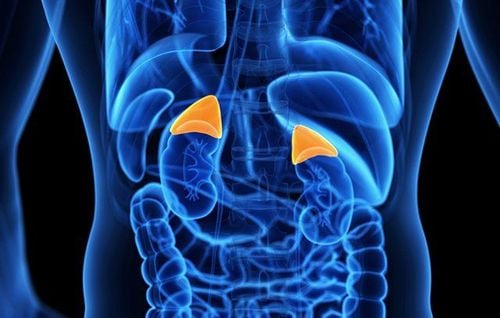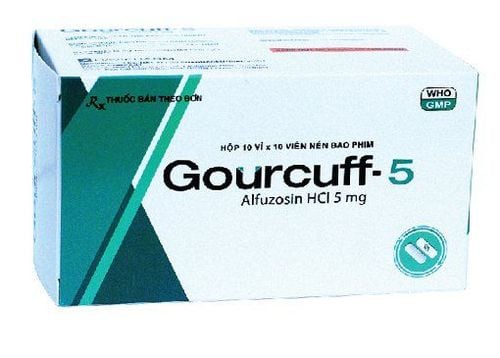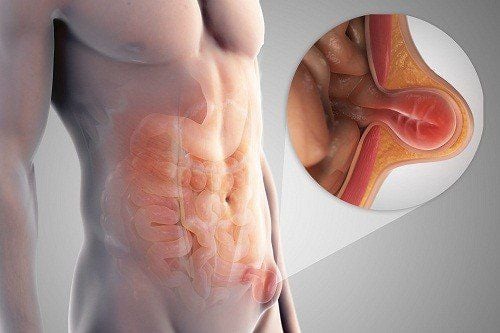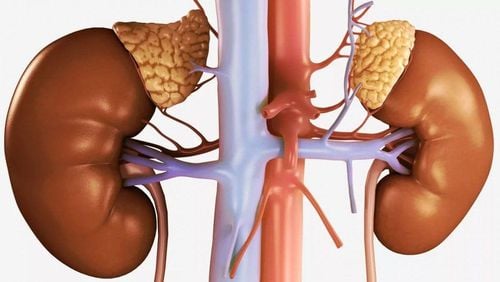This is an automatically translated article.
The article is professionally consulted by Master, Doctor Nguyen Tan Cuong - Head of Urology Department, Department of General Surgery - Vinmec Central Park International General Hospital.
Adrenal gland tumors can disrupt the production of certain hormones (hormones) in the body, leading to many serious health problems. Surgery is the curative treatment in many cases of benign and malignant adrenal tumors. Robot-assisted surgery is a promising new approach to improve treatment efficiency and patient safety.
1. What is an adrenal tumor?
The adrenal gland is a gland located above the two kidneys. The adrenal glands secrete hormones that help the body fight stress, balance electrolytes, regulate blood pressure, control immune system activity, and repair cell tissues during inflammation, injury, etc. Adrenal tumors are rare tumors that develop in the adrenal glands and are usually benign, with only a very rare occurrence being malignant (cancerous). Adrenal neoplasms usually occur in only one of the adrenal glands, but in some cases, both.
Adrenal tumors can present in many different conditions:
Asymptomatic: The patient is discovered incidentally during a general physical examination, ultrasound or computed tomography (CT Scan) shows an adrenal tumor kidney. Tumor has an endocrine function, manifested by the following syndromes: Adrenal medulloblastoma due to increased catecholamine secretion, causing hypertensive crisis. Cushing's syndrome is caused by an increase in cortisol secretion. Patients have symptoms of hypertension, edema, cushing faces, stretch marks... Hyperaldosteronism is caused by increased aldosterone secretion, which reduces blood potassium, leading to muscle weakness, increased blood pressure U causes increased secretion of sex hormones. sex.
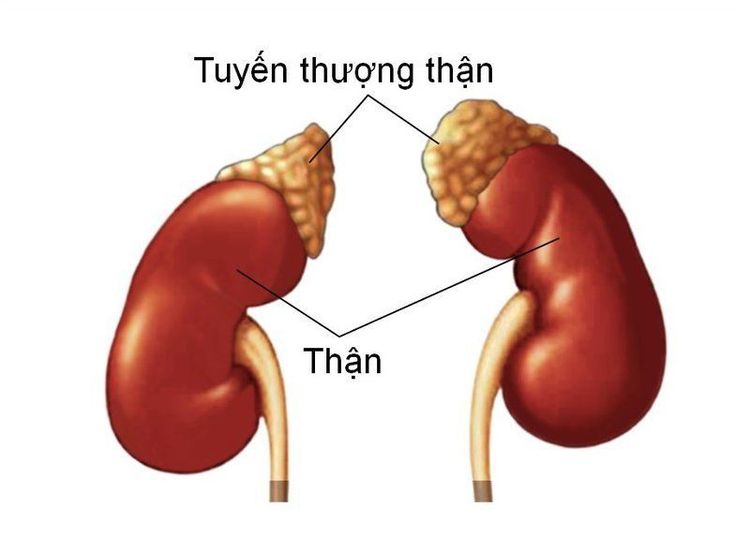
Tuyến thượng thận là tuyến nằm phía trên của hai quả thận
The typical symptom of adrenal myeloma is sudden, sudden episodes of paroxysmal hypertension. The patient's blood pressure rises very high, can reach 250-280/120-140 mmHg, lasts from a few minutes to a few hours, then decreases to normal. During a hypertensive crisis, the patient has symptoms such as tachycardia, palpitations, chest pain, headache, nausea, vomiting, frequent urination, pale skin, sweating, and cold body. Patient worries, panics, fear of death; After a hypertensive crisis, the patient is fatigued, the blood pressure is normal or it may drop, the body loses a lot of water, there may be electrolyte disturbances or heart failure. Hypertensive episodes can be triggered by physical exertion, stress, changes in the body, surgery, and anesthesia.
In some cases, the patient may have frequent high blood pressure, sometimes having a paroxysmal hypertensive crisis. Prolonged high blood pressure will lead to many dangerous complications such as myocardial infarction, coronary heart disease, heart failure, cerebrovascular accident, kidney failure, eye damage that can lead to blindness...
2. How are adrenal tumors treated?
If the adrenal adenoma is small (< 5cm) and has no endocrine function (no overproduction of adrenal hormones), the tumor is asymptomatic, discovered incidentally during laboratory testing diagnostic imaging may not require treatment. Patients will be periodically monitored, with endocrine and imaging tests to evaluate the tumor size and endocrine function of the adrenal gland.
If the adrenal tumor is more than 5cm in size or the adrenal tumor causes hormone hypersecretion (no matter how large or small), the patient needs to be treated surgically.
The treatment for adrenal tumors with endocrine function or large tumors > 5cm is surgery to remove the tumor.
Laparoscopic adrenalectomy is a difficult technique. Before surgery, the doctor may prescribe some drugs to use for 7-10 days to help stabilize blood pressure, these drugs can replace or supplement blood pressure medication the patient is using. In the majority of cases, the entire adrenal gland and the tumor will be removed. The remaining adrenal gland will take care of endocrine functions, produce hormones, and blood pressure will return to normal. However, if an adrenal gland was previously removed, the surgeon will remove only the tumor and keep healthy adrenal tissue.
There are two main methods of surgery for adrenal tumors today: open surgery and laparoscopic surgery. Laparoscopic adrenalectomy is favorable for tumors that are <5cm in size and are benign. Open surgery in cases where there are contraindications to laparoscopic surgery or the tumor is too large, heavily attached to surrounding organs.
If the adrenal tumor is cancerous or metastatic, in addition to surgery, the patient may be prescribed other treatments such as chemotherapy, radiation therapy, targeted therapy ...
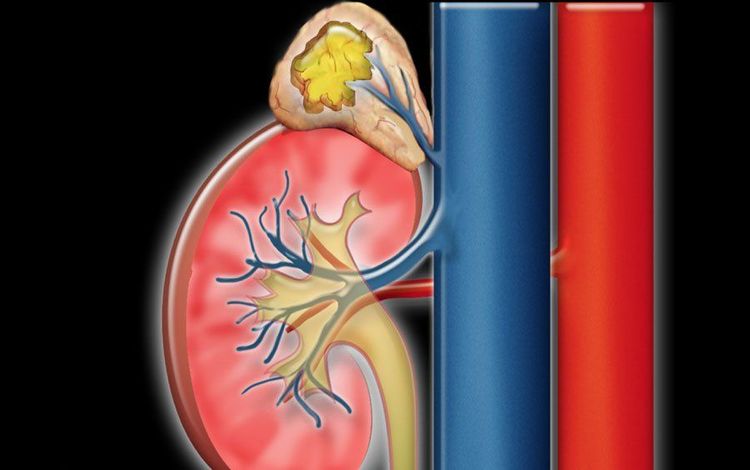
U tuyến thượng thận > 5cm sẽ gây tăng tiết hormone cần được điều trị sớm
3. Surgical method with robot support in the treatment of adrenal tumors
Surgery with robot support is a great development step of surgery, a promising new approach and a development trend of the surgical industry. Robotic-assisted surgery has many advantages over classic open and laparoscopic surgery.
With sophisticated, modern structure, perfectly simulate human hand operation, wide surgical angle up to 540 degrees that no human arm can do, three-dimensional magnified image is capable of diagnose and perform precise, minimally invasive surgery. Therefore, surgery with robot support brings high treatment efficiency and safety, reduces pain and complications for the patient, ensures aesthetics, helps shorten hospital stay, and recovers quickly. dress.
4. Where is the effective treatment for adrenal tumors?
From September 2019, Vinmec Central Park General Hospital (HCMC) has deployed a new technique - Robotic surgery with hand-held robots, applied to digestive and urological surgeries. and gynecology.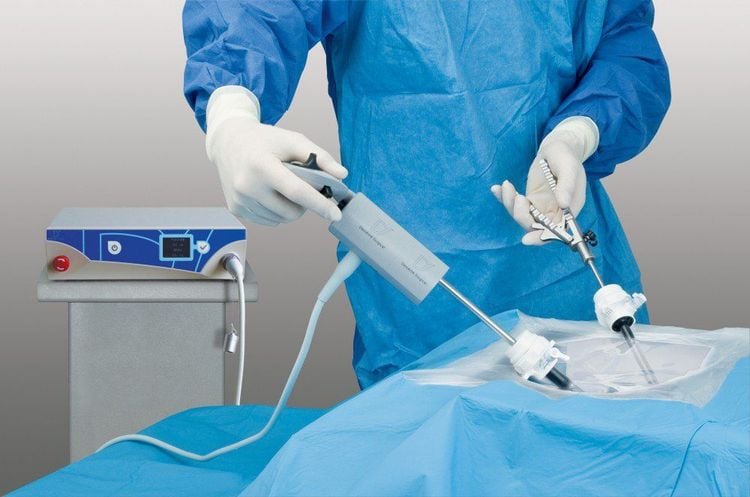
Phẫu thuật ít xâm lấn bằng robot (robotic surgery) với robot cầm tay tại Bệnh viện ĐKQT Vinmec Central Park (Tp. HCM)
This method has many advantages compared to both classical laparoscopic surgery and robotic surgery with:
Instruments with surgical heads that work as flexibly as wrist joints to help access narrow angles, increasing the possibility of dissection. separation and less damage to adjacent areas compared with classical laparoscopic surgery. Automated endoscopes through voice, laser, eye tracking, etc., help doctors actively control and have better vision and control, increase accuracy and safety in performing surgery art. With the advantage of compactness, robotic arm surgery is less invasive and has many advantages such as small incisions, less pain, low risk of infection, thereby helping customers to lose less blood during surgery, surgery, and quick recovery. . The cost is much lower than robotic surgery. Customers will be consulted and treated with experienced endoscopic doctors and directly received by Master, Doctor Nguyen Tan Cuong - Head of Urology Unit, Department of General Surgery - Vinmec International General Hospital Central Park performed the surgery.
Master. Doctor Nguyen Tan Cuong has nearly 20 years of experience working in the field of Urology - Men, especially in laparoscopic surgery for urinary tract diseases, minimally invasive surgery for urinary stones, cancer. urology and male genitalia, male infertility... Dr. Cuong has many articles published in domestic and foreign medical journals and is a member of the Vietnam Association of Urology, Nephrology, and Association American Urology, World Association of Urology Endoscopy.
For more advice on Urology Surgery promotion and to book an appointment for examination and treatment at Central Park International General Hospital, please contact Hotline: 0283 6221 166 or register online HERE THIS .




